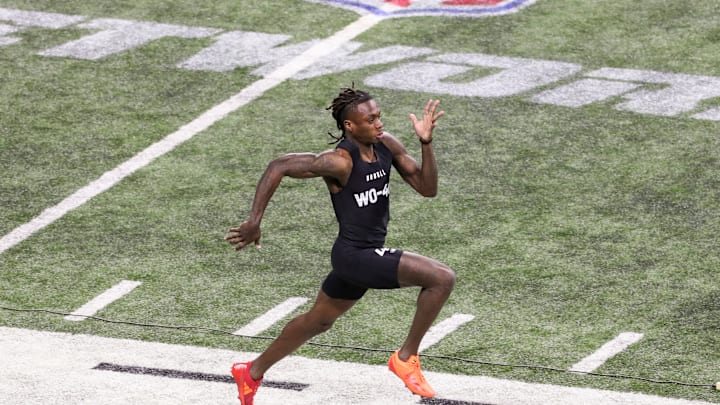The 2024 NFL combine is in the books, and, as always, the 40-yard dash clock times of the wide receivers are all-the-rage. Wideouts who can fly are always in fashion at the draft combine. Straight-line speed is a super-stat that makes sense for a wide receiver, while it may make little for some other positions (e.g., offensive line).
The topic of combine numbers and why certain traits for certain players do or don't make sense is worthy of extensive coverage. It won't get it here. The issue here is wide receivers, and that's very pertinent for the New England Patriots in this 2024 draft season. Wide receiver is a crucial draft objective (or at least should be) for this team which needs a total revamp of that unit.
Let's look at that stat that garners the most interest and commentary at the draft for wide receivers, their straight-line speed, or 40-yard dash times. Is this a solid indicator of future success or just a nice sideline that's fun to watch but not so important for projecting the future success of college-wide receivers in the NFL?
The Patriots can use speed at wide receiver, but separation and talent are more important.
This space is New England Patriots-centric. If it ain't about the Pats, it ain't much unless it directly impacts the home team. So, this issue will revolve around how draft speed has and may impact the Patriots. Let's start with a shining example of top speed and little production: Tyquan Thornton, a 2022 second-round pick burner.
Thornton would be the archetypal "beware" wide receiver in recent Patriots draft history for whom speed overcame other factors and led Bill Belichick to invest heavily in the player. No one at the 2022 combine nor after could doubt that Thornton was an F-22 jet on two feet. He can really fly.
In 2022, Thornton ran a sick 4.28-second 40-yard combine dash. For years, the Patriots had been self-clamoring for speed, breakaway speed in their wide receivers. The best past example in New England of a successful add (by trade, not the draft) was one Randy Moss, not only a blistering speedster but also a Hall-of-Fame receiver.
Forty-yard dash times are no indicator of success-potential
No one thought Thornton was Randy Moss, but he sure could run in a straight line. But is that the key to a wide receiver? It's a rhetorical question; we all know it's not. If you can't run a route and get open quickly (especially on a team with a lousy offensive line), you're not going to be much help to a team like the Patriots.
nfl.com's Lance Zierlein had this to say about Thornton after his combine,
" ... He's skinny and linear, which is a bad combination in defeating strong press-man corners on the next level. The poise and catch radius will work in his favor, but the success rate on contested catches will be lower than teams like, based upon his history and physical traits. Wideouts with his size profile have struggled mightily to succeed in the league, but Thornton's speed and talent make him worthy of a shot on Day 3."
Day three means the fourth round and later. Belichick traded up to select him at pick No. 50 in the second round. It's what's called a major draft "reach," and as NFL.com's Zierlein noted, wide receivers like Thornton struggle to make it in the NFL.
Thornton has justified that presumption. Hopefully, this year's head of drafting, Eliot Wolf, won't make the same mistakes Belichick did. In his first two years in the NFL thus far, Thornton hasn't been much help at all. He has a total of 35 catches for 338 yards and two touchdowns for the Patriots.
To put this in perspective, last year's sixth-round pick, Demario Douglas, ran a solid 4.44 forty at the combine. Yet, in 2023, he caught 49 passes for 561 yards (no TDs) in 14 games. It ain't about speed or even size. Thornton is 6'2" tall, while Douglas is 5'8" tall (or so!).
Thornton is just one example of how speed was a lure for the New England Patriots, and the player hasn't nearly measured up in performance to what his high draft status warranted. Conversely, Douglas, in a much smaller and nowhere near as blazingly fast package, has already left Thornton in the dust in their race to be a competent NFL wide receiver.
So, in evaluating wide receivers like Xavier Worthy, 2024's version of Thornton, who ran an even blistering 4.21-second forty, a new Combine record, beware of the allure of pure straight-line speed. While Worthy may turn out to be terrific, don't make speed the major determinant. Instead, draft a receiver with solid speed who can separate, aka get open, and catch the ball when it hits his hands. Your chances of drafting well at the position will likely improve.
